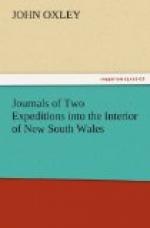continued along the edge of those valleys, our progress
much impeded by the vast trunks of fallen trees in
a state of decay, some of which were upwards of one
hundred and fifty feet long, without a branch, as
straight as an arrow, and from three to eight and ten
feet in diameter. The forest through which we
travelled appeared to be an elevated level or plain,
and at three o’clock in the afternoon, after
proceeding three or four miles to the westward, we
cleared this truly primeval forest, and descended
into a small valley of open ground, through which
ran the stream we had crossed in the morning.
Indeed we were not more than two miles south of the
place we had quitted. Our hope of proceeding
without much interruption was thus disappointed:
the gloominess of the weather, and the constant showers
that fell, so impeded our view and distorted its objects,
that what appeared plain and practicable at a distance
of two or three miles, when approached was found impassable.
I think it probable, however, that our most serious
obstructions will be the thickness of the timber, rotten
trees, and creeping plants; the soil is so rich and
free from rocks, that I do not think the steepness
of the descents will greatly endanger us. The
wind, which had been extremely violent all day, was
now accompanied by heavy showers; and we thought ourselves
extremely fortunate in not being obliged to encamp
in the forest. The storm as the evening advanced
increased to almost a hurricane, with torrents of rain.
Since Apsley River had been ascertained to take a
direction coast-wise, the principle which governed
the direction of our course had been to endeavour to
make a port on the coast laid down in lat. 30. 45.
S., and which I had an idea might probably receive
this river, now increased by a multitude of smaller
streams, and if so, that it might serve as a point
of communication with the fine country in the interior.
It is true this port is marked as a bar harbour; but
I knew that it had never been examined, and I was aware
how possible it was for a harbour to appear closed
by a reef from a ship sailing at a distance along
the coast. At all events the point was worth
ascertaining; and notwithstanding the repeated disappointments
we had experienced in attempting a north-easterly
course, I shall, if we are enabled to clear the deep
valleys we are at present embarrassed with, persevere
for some time longer. I consider it every way
important to know into what part of the coast these
waters are discharged.
September 19.—The storm continued to rage with unabated violence throughout the night and the whole of this day, accompanied by torrents of rain and hail: the weather was also extremely cold and bleak; the thermometer in the mornings and evenings being not more than 5 or 6 degrees above the freezing point: indeed, the season much nearer resembles the winter of a far more southern latitude than the spring of lat. 31.




